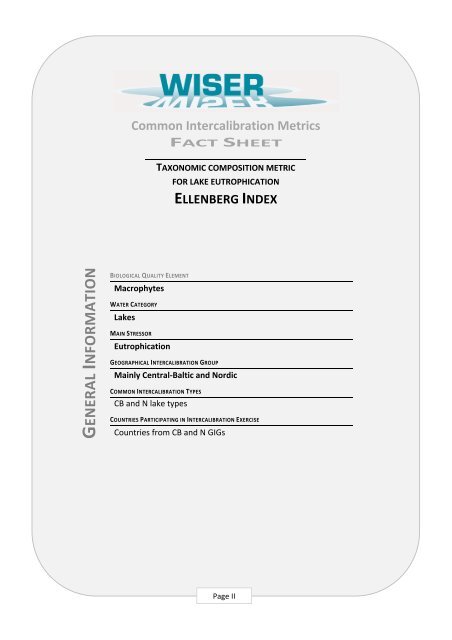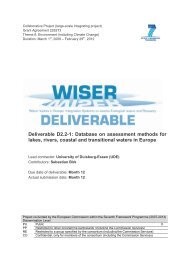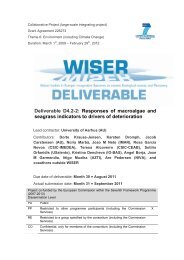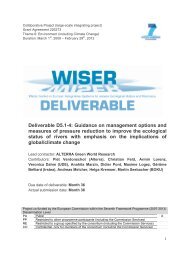Ellenberg index - WISER â Water bodies in Europe
Ellenberg index - WISER â Water bodies in Europe
Ellenberg index - WISER â Water bodies in Europe
You also want an ePaper? Increase the reach of your titles
YUMPU automatically turns print PDFs into web optimized ePapers that Google loves.
Common Intercalibration Metrics <br />
FACT SHEET <br />
TAXONOMIC COMPOSITION METRIC <br />
FOR LAKE EUTROPHICATION <br />
ELLENBERG INDEX <br />
GENERAL INFORMATION <br />
BIOLOGICAL QUALITY ELEMENT <br />
Macrophytes <br />
WATER CATEGORY <br />
Lakes <br />
MAIN STRESSOR <br />
Eutrophication <br />
GEOGRAPHICAL INTERCALIBRATION GROUP <br />
Ma<strong>in</strong>ly Central-‐Baltic and Nordic <br />
COMMON INTERCALIBRATION TYPES <br />
CB and N lake types<br />
COUNTRIES PARTICIPATING IN INTERCALIBRATION EXERCISE <br />
Countries from CB and N GIGs <br />
Page II
Common Intercalibration Metrics <br />
FACT SHEET <br />
TAXONOMIC COMPOSITION METRIC <br />
FOR LAKE EUTROPHICATION <br />
ELLENBERG INDEX <br />
SPECIFICATION <br />
COMMON METRIC DESCRIPTION (INCL. WFD’S INDICATIVE PARAMETERS) <br />
Trophic score system for vascular plants of central <strong>Europe</strong> <br />
elaborated <strong>in</strong> 80-‐ties of XX century by <strong>Ellenberg</strong> was used as an <br />
trophic <strong><strong>in</strong>dex</strong> alternative to ICM_LM. To calculate the <strong>Ellenberg</strong> <br />
Index (EI), macrophyte taxa <strong>in</strong>dicator values for nitrogen were <br />
used (no scores for phosphorus were elaborated by <strong>Ellenberg</strong>). <br />
For all the lakes <strong>in</strong> the database the <strong>Ellenberg</strong> Index was <br />
calculated as an average N-‐score value, both us<strong>in</strong>g total number <br />
of taxa (EI_TT) and only submerged taxa (EI_ST). <br />
COMBINATION RULE FOR MULTI-‐METRICS <br />
Not applicable <br />
SOFTWARE / (EXCEL) SPREADSHEET AVAILABLE FOR CALCULATING THE (INDIVIDUAL) COMMON METRIC(S) <br />
Not applicable <br />
AVAILABLE DOCUMENTS / ONLINE SOURCES REPORTING ON THE DEVELOPMENT OF COMMON METRIC(S) <br />
Deliverable 3.2-‐3 Report on the most suitable lake macrophyte <br />
based assessment methods for impacts of eutrophication and <br />
water level fluctuations; available at: www.wiser.eu <br />
Page III
Common Intercalibration Metrics <br />
FACT SHEET <br />
TAXONOMIC COMPOSITION METRIC <br />
FOR LAKE EUTROPHICATION <br />
ELLENBERG INDEX <br />
PRESSURES + ASSESSMENT SYSTEMS <br />
DESCRIPTION OF DATA SET TO ESTABLISH RELATIONSHIP TO PRESSURE / NATIONAL ASSESSMENT SYSTEMS 1<br />
The <strong>WISER</strong> common database <strong>in</strong>cludes macrophyte data from <br />
approximately 2000 lake-‐years from 16 countries. For test<strong>in</strong>g the <br />
response of macrophyte metrics to eutrophication the TP <br />
concentration was used as a pressure proxy. Both biological and TP <br />
data for over 1500 lake-‐years from 12 countries were available. <br />
Database was dom<strong>in</strong>ated by FI, SE and NO lakes followed by PL, LV and <br />
IE ones. From FR, DE and DK only three or two lakes were available. All <br />
the lakes belong to four GIGs (CB, N, ATL and EC), however the EC and <br />
ATL GIG were represented by a very few lakes only (17 and 13 <br />
respectively). No data from MED and ALP GIG were available. <br />
TYPE OF DOSE-‐RESPONSE-‐RELATIONSHIP 2<br />
S<strong>in</strong>ce EI:TP relationship was l<strong>in</strong>ear a log regression models was applied. <br />
The values of R 2 >0.30 and R>0.55 were assumed as sufficient to accept <br />
a metric as a well perform<strong>in</strong>g one. In a pool of all the lakes the EI:TP <br />
relationship was sufficiently strong (R 2 =0.47, R=0.68, p=0.000). In UK, <br />
NO, IE lakes a determ<strong>in</strong>ation and correlation coefficients reached a <br />
suggested values R 2 >0,3 and R>0.55, <strong>in</strong> rema<strong>in</strong><strong>in</strong>g countries be<strong>in</strong>g <br />
below the threshold level. The metric performed best <strong>in</strong> moderate <br />
alkal<strong>in</strong>ity lakes and weakest <strong>in</strong> high alkal<strong>in</strong>ity lakes. The metric response <br />
to eutrophication was stronger when <strong>in</strong>clud<strong>in</strong>g helophytes compared to <br />
this when only submerged taxa were considered. <br />
NATIONAL ASSESSMENT METHODS (OR PARTS THEREOF) RELATED TO THE COMMON METRIC(S) 3<br />
FEATURES OF THE RELATIONSHIP TO NATIONAL ASSESSMENT METHODS (OR PARTS THEREOF) 4<br />
Page IV
Common Intercalibration Metrics <br />
FACT SHEET <br />
TAXONOMIC COMPOSITION METRIC <br />
FOR LAKE EUTROPHICATION <br />
ELLENBERG INDEX <br />
REMARKS <br />
CONCLUDING REMARKS 1 <br />
The <strong>Ellenberg</strong> Index was a relatively well perform<strong>in</strong>g metric, however its <br />
usefulness for detect<strong>in</strong>g eutrophication <strong>in</strong> different countries and lake <br />
types was lower than as it was proved <strong>in</strong> the case of ICM_LM. <br />
Although the EI was related to nitrogen and the ICM_LM to phosphorus <br />
the relationship between these two <strong>in</strong>dices was very high (R 2 =0.85, <br />
R=0.92, p=0.000). In countries where macrophyte-‐based assessment <br />
methods have not been developed yet and no trophic scores for local <br />
flora is available, the <strong>Ellenberg</strong> Index can be considered as taxonomic <br />
composition component at first. <br />
When us<strong>in</strong>g EI it is recommended to <strong>in</strong>clude helophytes s<strong>in</strong>ce the <br />
assessment of eutrophication seems to be more reliable when more <br />
scored taxa are considered (the higher the number of the species with an <br />
<strong>in</strong>dicative value the more reliable the assessment). <br />
1<br />
short summary of rationale for common metric selection, major f<strong>in</strong>d<strong>in</strong>gs, and overall discussion <br />
Page V






